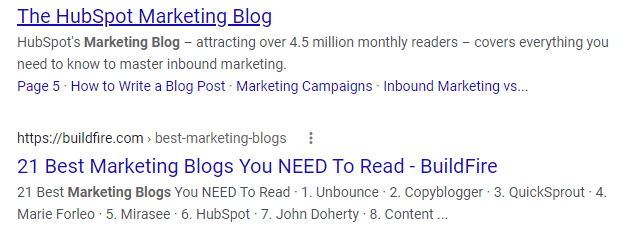Get a copy of the exact blog content calendar template I use for myself and my clients (for freeee!)
Browse by Category
I infuse personality and SEO to get you the blog results you've been looking for. Want to learn about how we can work together?
I'm the blog writer behind Maven Made Copy.
Hey, I’m Eden
Download my blog content calendar for FREE!
A blog page is a great way to improve your website SEO. When Google sees that you’re constantly updating your website with new and valuable content, it will rank you higher in search results. I encourage all business owners to have a blog page on their website for this reason. However, there are a few best practices that you should follow to give yourself the best chance to be ranked on the first page of Google. Let’s get into it.
1. Write at least 300 words
There’s a bit of debate on best practices around word count. Google likes to see pages that have at least 300 words, but the best performing blogs are over 1,000 words. It all depends on your audience. Do they like to read blogs, or do they prefer to consume content via video or audio? I recommend having all three. For example, record a podcast episode (audio), film yourself doing it (video), then transcribe it (blog). You can read more about repurposing content here.
2. Identify a few keywords and add them to your blog
You’ll want to have one main keyword that you use in the title of your blog, meta description, slug, and images. We’ll get to that in a minute. Then, you can identify similar words or phrases to use throughout your blog.
An easy way to do this is to create a Google Ads account. You can access their keyword tool for free. Search for words or phrases that relate to your blog topic and see what Google says are popular search terms. You’ll want to look for keywords or phrases that have low to medium competition and a mix of average monthly searches. In the Google Keyword Planning Tool, you’ll see ranges next to keywords. See the image below as an example. I recommend using a mix of keywords with low, medium, and high monthly searches.

Extra Tip: Don’t keyword stuff – meaning don’t purposefully add a bunch of keywords just for the sake of it. Integrate them in your blog naturally.
3. Break up the text with header tags
Header tags allow you to break up big chunks of text to make it easier to read and skim through. For example, notice how the title of each of the sections in this blog is bold and bigger? They are header tags. Use a mix of H1, H2, and H3 tags for even easier readability.
You’ll also want to add keywords to your header tags. It’s even more of an indication to Google of what you’re talking about.
4. Add images
Images are another way to break up the text. People love to see different forms of media in blogs. You can add images, gifs, or embed videos to support your main idea. They will help attract more attention to your blog and help your audience understand your content.
From an SEO perspective, Google is ramping up its virtual search feature. That means optimized images could be ranked highly when an image search is performed on Google. Then, they can click the link in your image to be taken to your blog. Did I forget to mention that? Include a link in your images, too. There’s so much to remember!
Extra Tip: Edit the alt text of your images with your main keyword.
5. Edit titles and descriptions
When you enter your blog title, most websites will automatically apply it as your slug (URL) and SEO title. You’ll want to edit both of these, so they are optimized. Remove filler words (such as a, the, to, etc.) from your slug and include keywords. See the URL for this blog as an example. The SEO title is what appears in search results (see below). It’s important that it’s not too long, or it’ll get cut off in search results. It’s the first thing people see, so it needs to be easy to understand and enticing.
You’ll also want to add a meta description when editing your backend SEO. It’s a 155 character summary of your blog. It’s the little paragraph that shows up under search results (see below). You’ll want to be clear about what your blog is about so someone searching knows if it’s right for them or not. An unclear meta description may lead to a high bounce rate, which will hurt how you’re ranked on Google.

6. Add internal and external links
Internal links are links to other pages on your website. External links are links to anything else on the internet. There are two types:
- Inbound links (or backlinks) – links from other websites to yours
- Outbound links – Links from your website to another website
Outbound links are what will improve your SEO. Google likes to see a mix of internal and outbound links in blogs. Outbound links are important to Google because it shows that other people are backing up your opinion.
I’ll also mention that inbound links, or backlinks, can hugely help your SEO, but you have little control over that happening. You can always approach other businesses in your industry to collaborate on content to get backlinks, but it needs to be mutually beneficial. It requires a little more work than simply adding a link, but it can really benefit your SEO ranking.
7. Include a call-to-action
Call-to-actions can be your inbound link. ALWAYS have at least one call-to-action in your blog. You’re telling people what the next step is after reading your blog. Here are a few ideas that you could include:
- Subscribe to my newsletter
- Book a discovery call with me
- Read this blog
- Download this freebie
- Connect with me on Instagram
How many call-to-actions do I have in this blog? Are they included naturally? Learn more about why you should always include a call to action in this blog.
I hope these best practices help you understand how to get your blog ranked on Google. It does take some thought. You can’t just throw words on a page and be done. I recommend implementing these best practices in future AND past blogs. It’s worth it to go back and edit past blogs with these best practices. In fact, just the act of updating past blog posts will improve SEO, too.
If you want help getting your blog up and running or managed, view my blog management services. I’d be happy to help get your blog and website seen by more people.
More For You To Enjoy



